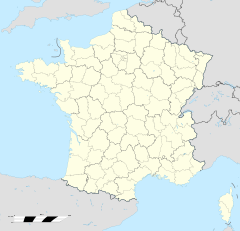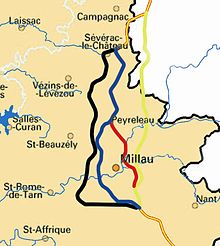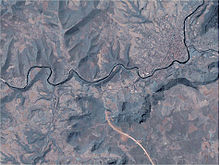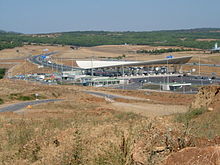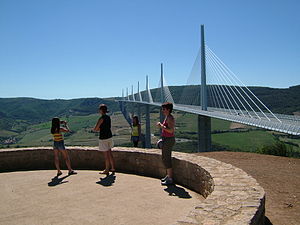
Millau Viaduct
Background to the schools Wikipedia
SOS Children, an education charity, organised this selection. Before you decide about sponsoring a child, why not learn about different sponsorship charities first?
| Millau Viaduct | |
|---|---|
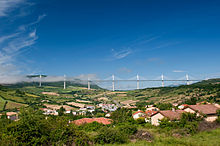 |
|
| Official name | Le Viaduc de Millau |
| Carries | 4 lanes of the A75 autoroute |
| Crosses | Valley of the River Tarn |
| Locale | Millau-Creissels, France |
| Architect | Michel Virlogeux, Norman Foster |
| Design | Cable-stayed bridge |
| Total length | 2460 m |
| Width | 32.05 m |
| Height | 343 m (max pylon above ground) |
| Longest span | 342 m |
| Number of spans | 204 m, 6×342 m, 204 m |
| Clearance below | 270 m (890 ft) |
| Construction begin | 16 October 2001 |
| Construction cost | € 394,000,000 |
| Opened | 16 December 2004 09:00 |
| Inaugurated | 14 December 2004 |
| Coordinates | 44°04′46″N 03°01′20″E Coordinates: 44°04′46″N 03°01′20″E |
The Millau Viaduct (French: le Viaduc de Millau, IPA: [vjadyk də mijo]) is a cable-stayed bridge that spans the valley of the river Tarn near Millau in southern France.
Designed by the French structural engineer Michel Virlogeux and British architect Norman Foster, it is the tallest bridge in the world with one mast's summit at 343.0 metres (1,125 ft) above the base of the structure. It is the 12th highest bridge deck in the world, being 270 metres (890 ft) between the road deck and the ground below.
Millau Viaduct is part of the A75-A71 autoroute axis from Paris to Montpellier. Construction cost was approximately €400 million. It was formally dedicated on 14 December 2004, inaugurated on the 15th, and opened to traffic on the 16th. The bridge has been consistently ranked as one of the great engineering achievements of all time. The bridge received the 2006 International Association for Bridge and Structural Engineering Outstanding Structure Award.
History
Problems with traffic on the route from Paris to Spain along the stretch passing through the valley near the town of Millau, especially during the summer when the roads became jammed with holiday traffic, required construction of a bridge to span the valley. The first plans were discussed in 1987 by CETE, and by October 1991, the decision was made to build a high crossing of the Tarn River by a structure of around 2,500 m (8,200 ft). During 1993–1994 the government consulted with seven architects and eight structural engineers. During 1995–1996, a second definition study was made by five associated architect groups and structural engineers. In January 1995, the government issued a declaration of public interest to solicit design approaches for a competition.
In July 1996, the jury decided in favour of a cable-stayed design with multiple spans, as proposed by the Sogelerg consortium ( Michel Virlogeux and Norman Foster). The decision to proceed by grant of contract was made in May 1998; then in June 2000 the contest for the construction contract was launched, open to four consortia. In March 2001 Eiffage established the subsidiary Compagnie Eiffage du Viaduc de Millau (CEVM) and was declared winner of the contest and awarded the prime contract in August.
Possible routes
In initial studies, four options were examined:
- Great Eastern (grand Est) ( yellow route ) passing east of Millau and crossing the valleys of the Tarn and Dourbie on two very high and long bridges (spans of 800 m/2,600 ft and 1,000 m/3,300 ft) whose construction was acknowledged to be problematic. This option would have allowed access to Millau only from the Larzac plateau, using the long and tortuous descent from La Cavalerie. Although this option was shorter and better suited to through traffic, it was abandoned because it did not satisfactorily serve the needs of Millau and its area .
- Great Western (grand Ouest) ( black route ), longer than the eastern option by 12 km (7.5 mi), following the Cernon valley. Technically easier (requiring four viaducts), this solution was judged to have negative impacts on the environment, in particular on the picturesque villages of Peyre and Saint-Georges-de-Luzençon. More expensive than the preceding option, and serving the region badly, this option was also abandoned.
- Near RN9 (proche de la RN9) ( red route ), would have served the town of Millau well, but presented technical difficulties and would have had a strong impact on existing or planned structures. This option was also abandoned.
- Intermediate (médiane), west of Millau ( blue route ) was supported by local opinion, but presented geological difficulties, notably on the question of crossing the valley of the Tarn. Expert investigation concluded that these obstacles were not insurmountable.
The fourth option was selected by ministerial decree on 28 June 1989. It encompassed two possibilities:
- the high solution, envisaging a 2,500 m (8,200 ft) viaduct more than 200 m (660 ft) above the river;
- the low solution, descending into the valley and crossing the river on a 200 m (660 ft) bridge, then a viaduct of 2,300 m (7,500 ft) extended by a tunnel on the Larzac side.
After long construction studies by the Ministry of Public Works, the low solution was abandoned because it would have intersected the water table, had a negative impact on the town, cost more, and lengthened the driving distance. The choice of the "high" solution was decided by ministerial decree on October 29, 1991.
After the choice of the high viaduct, five teams of architects and researchers worked on a technical solution. The concept and design for the bridge was devised by French designer Michel Virlogeux. He worked with the Dutch engineering firm ARCADIS, responsible for the structural engineering of the bridge.
Choosing the definitive route
The "high solution" required the construction of a 2,500 m (8,200 ft) long viaduct (about one and a half miles). From 1991 to 1993, the structures division of Sétra, directed by Michel Virlogeux, carried out preliminary studies and examined the feasibility of a single structure spanning the valley. Taking into account technical, architectural and financial issues, the Administration of Roads opened the question for competition among structural engineers and architects to widen the search for realistic designs. By July 1993, 17 structural engineers and 38 architects applied as candidates for the preliminary studies. With the assistance of a multidisciplinary commission, the Administration of Roads selected 8 structural engineers for a technical study and 7 architects for the architectural study.
Choice of technical design
Simultaneously, a school of international experts representing a wide spectrum of expertise (technical, architectural and landscape), chaired by Jean-François Coste, was established to clarify the choices that had to be made. In February 1995, on the basis of proposals of the architects and structural engineers, and with support of the school of experts, five general designs were identified.
The competition was relaunched: five combinations of architects and structural engineers, drawn from the best candidates of the first phase, were formed; each was to conduct in-depth studies of one of the general designs. On 15 July 1996, Bernard Pons, minister of Public Works, announced the decision of the jury, which was constituted of elected artists and experts and chaired by Christian Leyrit, the director of highways. The solution of a cable-stayed bridge, presented by the structural engineering group Sogelerg, Europe Etudes Gecti and Serf and the architects Foster + Partners was declared the best.
Detailed studies were carried out by the successful consortium, steered by the highways authority until mid-1998. After wind tunnel tests, the shape of the road deck was altered and detailed corrections were made to the design of the pylons. When the details were eventually finalised, the whole design was approved in late 1998.
Contractors
Once the Ministry of Public Works had taken the decision to offer the construction and operation of the viaduct as a grant of contract, an international call for tenders was issued in 1999. Four consortia tendered:
- Compagnie Eiffage du Viaduc de Millau (CEVM), led by Eiffage
- PAECH Construction Enterprise (Poland)
- a consortium led by the Spanish company Dragados, with Skanska (Sweden), and Bec (France)
- Société du Viaduc de Millau, including the French companies ASF, Egis, GTM, Bouygues Travaux Publics, SGE, CDC Projets, Tofinso and the Italian company Autostrade
- a consortium led by Générale Routière, with Via GTI (France) and Cintra, Nesco, Acciona and Ferrovial Agroman (Spain).
Piers were built with LAFARGE high performance cement. The pylons of the Millau viaduct, which are the tallest elements (the tallest pylon – 244.96 m) were produced and mounted by PAECH Construction Enterprise from Poland.
The Compagnie Eiffage du Viaduc de Millau, working with the architect Sir Norman Foster, was successful in obtaining the tender. Because the government had already taken the design work to an advanced stage, the technical uncertainties were considerably reduced. A further advantage of this process was to make negotiating the contract easier, reducing public expense and speeding up construction, while minimising such design work as remained for the contractor.
All the member companies of the Eiffage group had some role in the construction work. The construction consortium was made up of the Eiffage TP company for the concrete part, the Eiffel company for the steel roadway ( Gustave Eiffel built the Garabit viaduct in 1884, a railway bridge in the neighbouring Cantal département), and the Enerpac company for the roadway's hydraulic supports. The engineering group Setec has authority in the project, with SNCF engineering having partial control. Appia was responsible for the job of the bituminous coating on the bridge deck, and Forclum for electrical installations. Management was handled by Eiffage Concessions.
The only other business that had a notable role on the building site was Freyssinet, a subsidiary of the Vinci Group specialising in prestressing. It installed the cable stays and put them under tension, while the prestress division of Eiffage was responsible for prestressing the pillar heads.
The steel deck and the hydraulic action of the deck were designed by the Walloon engineering firm Greisch from Liège, Belgium, also an Information and communication technologies company of the Walloon Region. They carried out the general calculations and the resistance calculations for winds of up to 225 km/h (140 mph). They also applied the launching technology.
The sliding shutter technology for the bridge piers came from PERI.
Opposition
Numerous organizations opposed the project, including the WWF, France Nature Environnement, the national federation of motorway users, and Environmental Action. Opponents advanced several arguments:
- The westernmost route would be better, longer by three kilometres but a third of the cost with its three more conventional structures.
- The objective of the viaduct would not be achieved; because of the toll, the viaduct would be little used and the project would not solve Millau's congestion problems.
- The project would never break even; toll income would never amortise the initial investment and the contractor would have to be supported by subsidies.
- The technical difficulties were too great and the bridge would be dangerous and unsustainable; the pylons, sitting on the shale of the Tarn Valley, would not support the structure adequately.
- The viaduct represented a detour, reducing the number of visitors passing through Millau and slowing its economy.
Construction
Two weeks after the laying of the first stone on 14 December 2001, the workers started to dig the deep shafts. There were 4 per pylon; 15 m (49 ft) deep and 5 m (16 ft) in diameter, assuring the stability of the pylons. At the bottom of each pylon, a tread of 3–5 m (10–16 ft) in thickness was installed to reinforce the effect of the deep shafts. The 2,000 m3 (2,600 cu yd) of concrete necessary for the treads was poured at the same time.
In March 2002, the pylons emerged from the ground. The speed of construction then rapidly increased. Every three days, each pylon increased in height by 4 m (13 ft). This performance was mainly due to sliding shuttering. Thanks to a system of shoe anchorages and fixed rails in the heart of the pylons, a new layer of concrete could be poured every 20 minutes.
The bridge deck was constructed on land at the ends of the viaduct and rolled lengthwise from one pylon to the next, with eight temporary towers providing additional support. The movement was accomplished by a computer-controlled system of pairs of wedges under the deck; the upper and lower wedges of each pair pointing in opposite directions. These were hydraulically operated, and moved repeatedly in the following sequence: The lower wedge slides under the upper wedge, raising it to the roadway above and then forcing the upper wedge still higher to lift the roadway. Both wedges move forward together, advancing the roadway a short distance. The lower wedge retracts from under the upper wedge, lowering the roadway and allowing the upper wedge to drop away from the roadway; the lower wedge then moves back all the way to its starting position. There is now a linear distance between the two wedges equal to the distance forward the roadway has just moved. The upper wedge moves backward, placing it further back along the roadway, adjacent to the front tip of the lower wedge and ready to repeat the cycle and advance the roadway by another increment. It worked at 600 mm per cycle which was roughly four minutes long.
The mast pieces were driven over the new deck lying down horizontally. The pieces were joined to form the one complete mast, still lying horizontally. The mast was then tilted upwards, as one piece, at one time in a tricky operation. In this way each mast was erected on top of the corresponding pylon. The stays connecting the masts and the deck were then installed, and the bridge was tensioned overall and weight tested. After this, the temporary pylons could be removed.
- Timeline
- 16 October 2001: work begins
- 14 December 2001: laying of the first stone
- January 2002: laying pier foundations
- March 2002: start of work on the pier support C8
- June 2002: support C8 completed, start of work on piers
- July 2002: start of work on the foundations of temporary, height adjustable roadway supports
- August 2002: start of work on pier support C0
- September 2002: assembly of roadway begins
- November 2002: first piers complete
- 25–26 February 2003: laying of first pieces of roadway
- November 2003: completion of the last piers (Piers P2 at 245 m (804 ft) and P3 at 221 m (725 ft) are the highest piers in the world.)
- 28 May 2004: the pieces of roadway are several centimetres apart, their juncture to be accomplished within two weeks
- 2nd half of 2004: installation of the pylons and shrouds, removal of the temporary roadway supports
- 14 December 2004: official inauguration
- 16 December 2004: opening of the viaduct, ahead of schedule
- 10 January 2005: initial planned opening date
Construction records
The bridge’s construction broke several records:
- The highest pylons in the world: pylons P2 and P3, 244.96 metres (803 ft 8 in) and 221.05 metres (725 ft 3 in) in height respectively, broke the French record previously held by the Tulle and Verrières viaducts (141 m/463 ft), and the world record previously held by the Kochertal Viaduct (Germany), which is 181 metres (594 ft) at its highest;
- The highest bridge tower in the world: the mast atop pylon P2 peaks at 343 metres (1,125 ft).
- The highest road bridge deck in Europe, 270 m (890 ft) above the Tarn River at its highest point. It is nearly twice as tall as the previous tallest vehicular bridges in Europe, the Europabrücke in Austria and the Italia Viaduct in Italy. It is slightly higher than the New River Gorge Bridge in West Virginia in the United States, which is 267 m (876 ft) above the New River. Since opening in 2004, the deck height of Millau has been surpassed by several suspension bridges in China, including Siduhe, Balinghe and two spans ( Beipanjiang River 2003 Bridge and Beipanjiang River 2009 Bridge) over the Beipanjiang River. In 2012, Mexico's Baluarte Bridge surpassed Millau as the world's highest cable-stayed bridge. The Royal Gorge suspension bridge in the U.S. state of Colorado is also higher, with a bridge deck approximately 291 metres (955 ft) over the Arkansas River.
Location
The Millau Viaduct is located on the territory of the communes of Millau and Creissels, France, in the département of Aveyron. Before the bridge was constructed, traffic had to descend into the Tarn River valley and pass along the route nationale N9 near the town of Millau, causing heavy congestion at the beginning and end of the July and August holiday season. The bridge now traverses the Tarn valley above its lowest point, linking two limestone plateaus, the Causse du Larzac and the Causse Rouge, and is inside the perimeter of the Grands Causses regional natural park.
The bridge forms the last link of the A75 autoroute (la Méridienne), from Clermont-Ferrand to Pézenas (to be extended to Béziers by 2010). The A75, with the A10 and A71, provides a continuous high-speed route south from Paris through Clermont-Ferrand to the Languedoc region and through to Spain, considerably reducing the cost of vehicle traffic travelling along this route. Many tourists heading to southern France and Spain follow this route because it is direct and without tolls for the 340 kilometres (210 mi) between Clermont-Ferrand and Pézenas, except for the bridge itself.
The Eiffage group, which constructed the viaduct, also operates it, under a government contract which allows the company to collect tolls for up to 75 years. The toll bridge costs €6.40 for light automobiles (€7.40 during the peak months of July and August).
Structure
Pylons and abutments
Each pylon is supported by four deep shafts, 15 m (49 ft) deep and 5 m (16 ft) in diameter.
| P1 | P2 | P3 | P4 | P5 | P6 | P7 |
|---|---|---|---|---|---|---|
| 94.501 m (310 ft 0.5 in) | 244.96 m (803 ft 8 in) | 221.05 m (725 ft 3 in) | 144.21 m (473 ft 2 in) | 136.42 m (447 ft 7 in) | 111.94 m (367 ft 3 in) | 77.56 m (254 ft 6 in) |
The abutments are concrete structures that provide anchorage for the deck to the ground in the Causse du Larzac and the Causse Rouge.
Deck
The metallic deck, which appears very light despite its total mass of around 36,000 tonnes (40,000 short tons), is 2,460 m (8,070 ft) long and 32 m (105 ft) wide. It comprises eight spans. The six central spans measure 342 m (1,122 ft), and the two outer spans are 204 metres (669 ft). These are composed of 173 central box beams, the spinal column of the construction, onto which the lateral floors and the lateral box beams were welded. The central box beams have a 4 m (13 ft) cross-section and a length of 15–22 m (49–72 ft) for a total weight of 90 metric tons (99 short tons). The deck has an inverse Airfoil shape, providing negative lift in strong wind conditions.
Masts
The seven masts, each 87 m (285 ft) high and weighing around 700 tonnes (690 long tons; 770 short tons), are set on top of the pylons. Between each of them, eleven stays (metal cables) are anchored, providing support for the road deck.
Stays
Each mast of the viaduct is equipped with a monoaxial layer of eleven pairs of stays laid face to face. Depending on their length, the stays were made of 55 to 91 high tensile steel cables, or strands, themselves formed of seven strands of steel (a central strand with six intertwined strands). Each strand has triple protection against corrosion ( galvanisation, a coating of petroleum wax and an extruded polyethylene sheath). The exterior envelope of the stays is itself coated along its entire length with a double helical weatherstrip. The idea is to avoid running water which, in high winds, could cause vibration in the stays and compromise the stability of the viaduct.
The stays were installed by the Freyssinet company.
Surface
To allow for deformations of the metal deck under traffic, a special surface of modified bitumen was installed by research teams from Appia. The surface is somewhat flexible to adapt to deformations in the steel deck without cracking, but it must nevertheless have sufficient strength to withstand motorway conditions (fatigue, density, texture, adherence, anti-rutting etc.). The "ideal formula" was found only after two years of research.
Electrical installations
The electrical installations of the viaduct are large in proportion to the size of the bridge. There are 30 km (19 mi) of high-current cables, 20 km (12 mi) of fibre optics, 10 km (6.2 mi) of low-current cables and 357 telephone sockets allowing maintenance teams to communicate with each other and with the command post. These are situated on the deck, on the pylons and on the masts.
As far as instrumentation is concerned, the viaduct is state of the art. The pylons, deck, masts and stays are equipped with a multitude of sensors. These are designed to detect the slightest movement in the viaduct and measure its resistance to wear-and-tear over time. Anemometers, accelerometers, inclinometers, temperature sensors are all used for the instrumentation network.
Twelve fibre optic extensometers were installed in the base of pylon P2. Being the tallest of all, it is therefore under the most intense stress. These sensors detect movements on the order of a micrometre. Other extensometers—electrical this time—are distributed on top of P2 and P7. This apparatus is capable of taking up to 100 readings per second. In high winds, they continuously monitor the reactions of the viaduct to extreme conditions. Accelerometers placed strategically on the deck monitor the oscillations that can affect the metal structure. Displacements of the deck on the abutment level are measured to the nearest millimetre. The stays are also instrumented, and their ageing meticulously analysed. Additionally, two piezoelectric sensors gather traffic data: weight of vehicles, average speed, density of the flow of traffic, etc. This system can distinguish between fourteen different types of vehicle.
The data is transmitted by an Ethernet network to a computer in the IT room at the management building situated near the toll plaza.
Toll plaza
The only toll plaza on the A75 autoroute, the bridge toll booths and the buildings for the commercial and technical management teams are situated 4 km (2.5 mi) north of the viaduct. The toll plaza is protected by a canopy in the shape of a leaf (formed from tendrilled concrete, using the ceracem process). Consisting of 53 elements ( voussoirs), the canopy is 100 m (330 ft) long and 28 m (92 ft) wide. It weighs around 2,500 tonnes (2,500 long tons; 2,800 short tons).
The toll plaza can accommodate sixteen lanes of traffic, eight in each direction. At times of low traffic volume, the central booth is capable of servicing vehicles in both directions. A car park and viewing station, equipped with public toilets, is situated each side of the toll plaza. The total cost was €20 million.
Statistics
- 2,460 m (8,071 ft): total length of the roadway
- 7: number of piers
- 77 m (253 ft): height of Pier 7, the shortest
- 343 m (1,125 ft): height of Pier 2, the tallest (245 m/804 ft at the roadway's level)
- 87 m (285 ft): height of a mast
- 154: number of shrouds
- 270 m (886 ft): average height of the roadway
- 4.20 m (13 ft 9 in): thickness of the roadway
- 32.05 m (105 ft 2 in): width of the roadway
- 85,000 m3 (111,000 cu yd): total volume of concrete used
- 290,000 metric tons (320,000 short tons): total weight of the bridge
- 10,000–25,000 vehicles: estimated daily traffic
- €6.00–7.50: typical automobile toll, as of December 2009
- 20 km (12 mi): horizontal radius of curvature of the road deck
Impact and events
Pedestrian sporting events
Unusual for a bridge closed to pedestrians, a run took place in 2004 and another on 13 May 2007:
- December 2004 – 19,000 walkers and runners of the Three Bridge Walk had the privilege of crossing the bridge deck for the first time, but the walk was not authorised to go further than pylon P1; the bridge was still closed to traffic.
- 13 May 2007 – 10,496 runners took the departure of the race which from Place de Mandarous, in the centre of Millau, to the southern end of the viaduct. After starting on the northern side, they crossed the viaduct then retraced their steps. Total distance: 23.7 km (14.7 mi).
Events and popular culture
- In 2004, a fire started on the slope of causse rouges because of a spark originating from a welder. Some trees were destroyed in the fire.
- The speed limit on the bridge was reduced from 130 km/h (81 mph) to 110 km/h (68 mph) because tourists were slowing down to take photos. Soon after the bridge opened to traffic, cars were stopping on the hard shoulder so that travelers could view the landscape and the bridge.
- A stamp was designed by Sarah Lazarevic to commemorate the opening of the viaduct.
- The Chinese transport minister at the time visited the bridge on the first anniversary of its opening. The commission was impressed by the technical prowess of the bridge’s immense construction, but also by the legal and financial assembly of the viaduct. However, according to the minister, he did not envisage building a counterpart in People's Republic of China.
- The cabinet of the governor of California Arnold Schwarzenegger, who envisaged the construction of a bridge in San Francisco Bay, asked the council of the town hall of Millau about the popularity of the construction of the viaduct.
- This bridge was featured in a scene of the film Mr. Bean's Holiday.
- The hosts of the British motoring show, Top Gear, featured the bridge during Series 7, when they took a Ford GT, Pagani Zonda, and Ferrari F430 Spyder on a road trip across France to see the newly completed bridge.
- Richard Hammond, one of the above hosts on Top Gear, explored the engineering aspects in the construction of the Millau Viaduct in Series 2 of Richard Hammond's Engineering Connections.
- The Spanish photographer Aitor Ortiz featured the pylons of the bridge in one of his photographic series.
